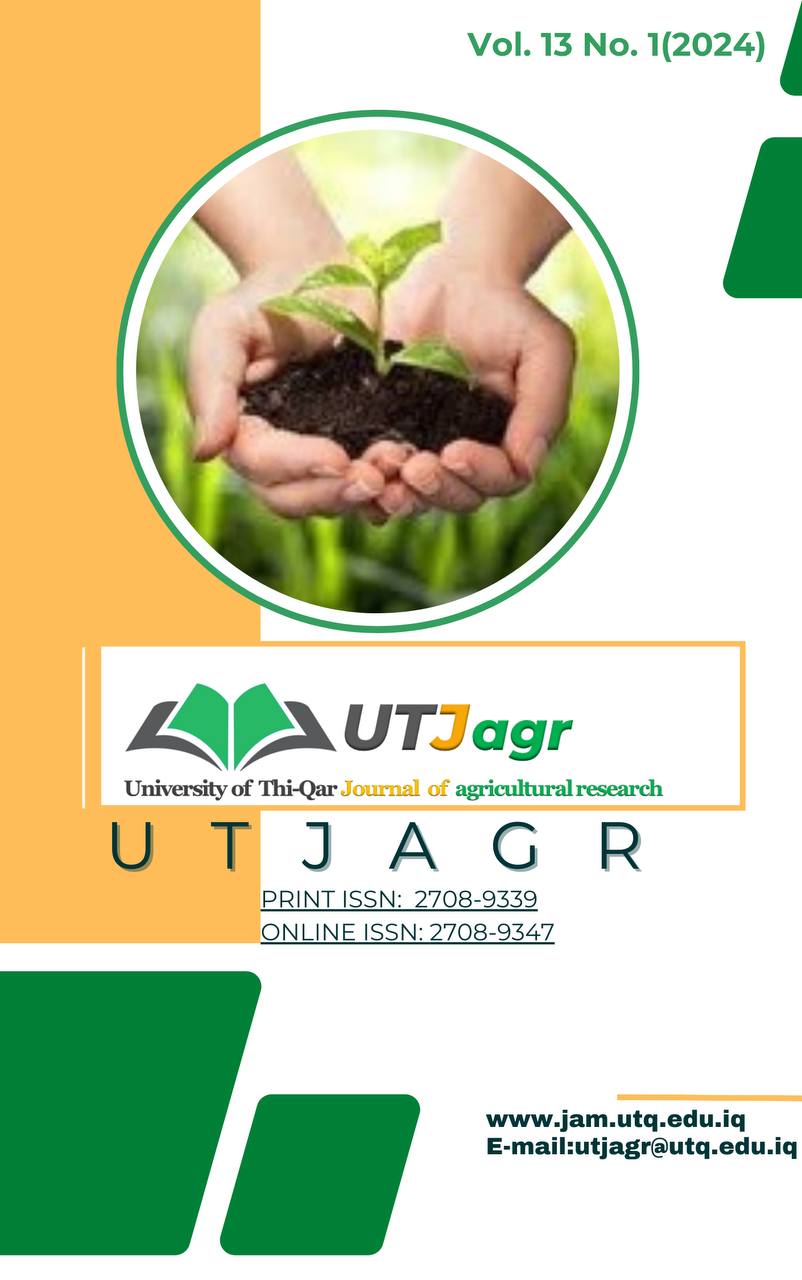Indirect shoot regeneration from callus of the shoot tip explants of Gerbera jamesonii Bolus cv. "Festival"
DOI:
https://doi.org/10.54174/hdgrg741Keywords:
Callus, cultivar, indirect shoot, micropropagation, proliferation, MS salts.Abstract
The study was conducted in the Tissue Culture Laboratory, Fadak Agricultural Company, Basrah, Iraq. Mother plants of the “Festival” gerbera cultivar were used for micropropagation by taking the shoot tip explants. The concentration of 2 mgL-1 benzyl adenine (BA) resulted in recording the highest percentage of response to callus induction, reaching 90%, which was significantly superior to the other two treatments, 1 and 1.5mgL-1 BA. The 1 mgL-1 BA treatment was significantly superior in response to indirect shoot generation when compared with the 1.5 and 2 mgL-1 BA treatments. The 1 mgL-1 BA treatment recorded the highest percentage of response to shoot growth induced by callus, which reached 100%. The treatment of callus grown in MS medium supplied with BA concentration of 1 mgL-1 recorded the highest average number of shoots, which reached 10 shoots per 50 mg of callus. The MS medium treatment supplied with a concentration of 0.5 mgL-1 of naphthalene acetic acid (NAA) was significantly superior to the other two treatments of 1 and 1.5 mgL-1 NAA in the percentage of shoot response to root formation. The concentration of 0.5mgL-1 NAA recorded the highest response to root formation, which reached 100%. The treatment of the MS medium supplied with a concentration of 0.5 mgL-1 NAA was significantly superior to the treatments of 1 and 1.5 mgL-1 NAA in the average number of main roots formed on the shoots. This treatment recorded the highest average of main roots, amounting to 3.2 main roots shoot-1.
Callus, cultivar, indirect shoot, micropropagation, proliferation, MS salts.
Downloads
References
Al-Rawi, K.M., & Khalaf Allah, A.M. (2000). Design and Analysis of Agricultural Experiments. Dar Al Kutub for Printing and Publishing, College of Agriculture and Forestry, University of Mosul, Ministry of Higher Education and Scientific Research, Iraq, 488pp.
Aswath, C., Deepa, S. M., & Choudhary, M. L. (2003). Commercial multiplication of gerbera (Gerbera jamesonii Bolus) through in vitro shoot tip culture. Journal of Ornamental Horticulture, 6(4), 303-309.
Chung, M. Y., Kim, M. B., Chung, Y. M., Nou, I. S., & Kim, C. K. (2016). In vitro shoot regeneration and genetic transformation of the gerbera (Gerbera hybrida Hort.) cultivar ‘Gold Eye’. Journal of Plant Biotechnology, 43(2), 255-260.
Ibrahim, K. M., & Abdul–Hameed, S. (2001). The Narseries. The University of Musil. Univ. Mosul, Iraq. Press. Ministry of Higher Education, Iraq.
Jerzy, M., & Lubomski, M. (1991). Adventitious shoot formation on ex vitro derived leaf explants of Gerbera jamesonii. Scientia Horticulturae, 47(1-2), 115-124.
Kanwar, J. K., & Kumar, S. (2008). In vitro propagation of Gerbera-A review. Hort. Sci. (Prague), 35(1), 35-44.
Murashige, T., & Skoog, F. (1962). A revised medium for rapid growth and bio assays with tobacco tissue cultures. Physiologia Plantarum, 15(3), 473-497.
Murashige, T., Serpa, M., & Jones, J. B. (1974). Clonal Multiplication of Gerbera through Tissue Culture1. HortScience, 9(3), 175-180.
Orlikowska, T., Nowak, E., Marasek, A., & Kucharska, D. (1999). Effects of growth regulators and incubation period on in vitro regeneration of adventitious shoots from gerbera petioles. Plant Cell, Tissue and Organ Culture, 59, 95-102.
Parthasarathy, V. A. and Nagaraju, V. (1999). In vitro Propagation of Gerbera jamesonii Bolus. Indian J. Hort., 56: 82-85.
Puglisi, S. E. (2002). Use of plant growth regulators to enhance branching of Clematis spp. Master of Science, Department of Horticultural Science, Virginia Polytechnic Institute and State University, Blacksburg, VA.
Rout, G. R., & Jain, S. M. (2004). Micropropagation of ornamental plants-cut flowers. Propagation of Ornamental Plants, 4(2), 3-28.
Shelahi, S.A., Majeed, D.M., Hassan, S.M. (2013). Propagation of Gerbera (Gerbera Jasmonii Bolus.) by using a tissue culturetechnique. J. Biotechnol. Res. Cent,7(1), 50-8.
Singh, V. K., Singh, D., Kumari, S., Jabbar, A., & Prasad, V. M. (2014). Evaluation of gerbera (Gerbera jamesonii) cultivars under shade net house condition. New Agriculturist, 25(1), 105-109.
Singh, V. K., Prasad, V. M., Kumari, S., Rajoria, P., & Misra, P. (2017). Identification of the suitable hardening protocol and hardening medium in micropropagation of gerbera (Gerbera jamesonii Bolus). Int. J. Curr. Microbiol. App. Sci, 6(7), 2476-84.
Son, N. V., Mokashi, A. N., Hegde, R. V., Patil, V. S., & Lingaraju, S. (2011). Response of gerbera (Gerbera jamesonii Bolus) varieties to micropropagation. Karnataka Journal of Agricultural Sciences, 24(3).
Teeri, T. H., Elomaa, P., Kotilainen, M., & Albert, V. A. (2006). Mining plant diversity: Gerbera as a model system for plant developmental and biosynthetic research. BioEssays, 28(7), 756-767.
Torbert, K. A., Rines, H. W., & Somers, D. A. (1998). Transformation of oat using mature embryo‐derived tissue cultures. Crop Science, 38(1), 226-231.
Williams, M. E. (2011). Introduction to Phytohormones. Teaching tools in plant biology: Lecture notes. The Plant Cell (online), doi/10.1105/tpc, 110
Wiesman, Z., Riov, J., & Epstein, E. (1989). Characterization and rooting ability of indole-3-butyric acid conjugates formed during rooting of mung beaan cuttings. Plant Physiology, 91(3), 1080-1084.

Downloads
Published
Issue
Section
License

This work is licensed under a Creative Commons Attribution-NonCommercial-ShareAlike 4.0 International License.







1.png)

